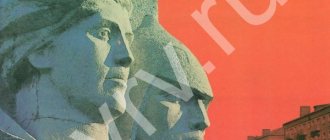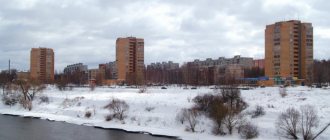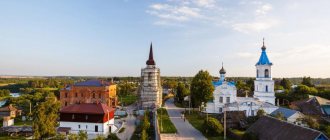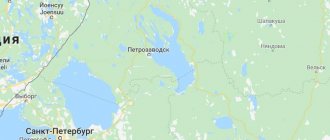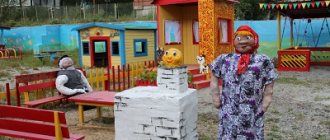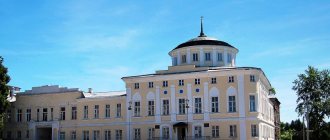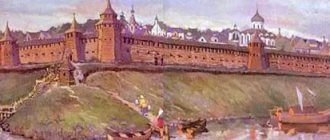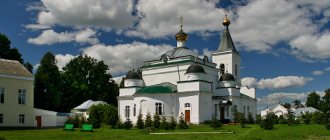Church of the Resurrection
The first mention of a wooden church dates back to 1577. The current cathedral was built in 1898. The temple was built with donations collected by local peasant Y.V. Larin.
In 1909, for the construction of the bell tower, a bell was brought to the city, which the local population carried to the cathedral in their hands. In the 30s of the last century, the church was destroyed and closed. It was returned to parishioners only in 1991 and to this day it is a functioning church.
Location: Voskresenskaya - 44A.
Church of John Chrysostom
The temple was erected in 1761. However, the bell tower and refectory were built only in 1855. The cathedral is designed in the provincial baroque style.
Each wall of the temple is decorated with figures of saints. In 1937, the church was closed and its rector was shot. But already in 1946 the shrine was returned to believers. In addition, a chapel was built on the territory of the cathedral, which contains the relics of Schema nun Nila, famous for the fact that she did not allow the Soviet authorities to plunder the church, for which she was sent into exile.
Church of St. Sergius of Radonezh
In 2000, a Sunday school was opened here, whose believers submitted the idea of building the St. Sergius Church to the local administration. In 2003, the church was built and was considered a monument to the valor of the fallen Soviet soldiers who participated in the Great Patriotic War. The consecration of the shrine took place in 2006.
Now it contains the relics of St. Sergius of Radonezh, in whose honor the church is named, as well as part of the mantle of Seraphim of Sarov and the relics of St. Fyodor Ushakov.
Location: Pervomaiskaya street - 25.
Voskresensk: temples and monasteries of the city
There are many various Orthodox shrines within the city and its surroundings - temples and churches, monasteries and monasteries, chapels and parishes. The main ones are discussed in this section of the material.
Novo-Solovetskaya Marchugovskaya men's hermitage
- Address: Staraya st., 57, Faustovo village.
The phrase “Solovetsky Monastery” evokes associations with the famous monument of the Russian North - a monastery lost on islands in the White Sea between the Arkhangelsk region and Karelia . However, in the Moscow region, in the village of Faustovo, not far from Voskresensk, this famous monastery complex has a working courtyard, or, in modern terms, a branch.
Officially, the Novo-Solovetsky Marchugovskaya Hermitage was founded in 1654, but historical documents contain references to the existence of a monastic settlement in these places at the end of the 15th century.
The main temple of the monastery is the Ascension Cathedral, an architectural monument of the “Naryshkin Baroque”. In total, there are three active churches on the territory of the monastery. They were all built in the second half of the 17th century and are interesting not only as functioning Orthodox religious sites, but also as magnificent examples of different architectural styles, combined into one ensemble.
Church of John Chrysostom
- Address: Novlyanskaya st., 14, Novlyansky microdistrict.
On Novlyanskaya Street in Voskresensk there is a temple of the late 18th century, built in the provincial Baroque style.
The Church of St. John Chrysostom attracts with its festive decoration; the façade is decorated with figurines of saints. In the 19th century it was reconstructed. There is a version that the famous architect O.I. had a hand in this reconstruction. Beauvais.
In the early Soviet period, parishioners defended the church, preventing it from being destroyed and looted. Already in 1946, after a short period of oblivion, it again opened its doors to believers and is still active.
Near the church there is a small chapel containing the relics of the locally revered Saint Nila. This nun was among those repressed by the Soviet regime.
Church of the Archangel Michael
- Address: village of Karpovo.
The church, modest in appearance, but distinguished by its elegance and special provincial charm, is the work of the architect N. Markov. Date of construction: 1884. Previously, there was a wooden church on this site. The modern temple was built using donations.
The names of everyone thanks to whom this Orthodox site appeared in the city are listed on a memorial plaque installed at the entrance to the church. In its entire history it has never been closed. The main shrine belonging to the temple is the icon of the Kazan Mother of God.
Church of St. Sergius of Radonezh
- Address: Lopatinsky microdistrict, Pervomaiskaya st., 29.
The wooden church in Voskresensk, consecrated in honor of St. Sergius, is not an ancient architectural monument. The temple was built in the 2000s. in memory of the soldiers of the Great Patriotic War who died at the fronts.
Despite its young age, the church has important shrines. Pieces of the relics of St. Sergius of Radonezh were transferred here. Part of the mantle of Seraphim of Sarov is also kept here.
Church of the Tikhvin Icon of the Mother of God
- Address: pos. them. Tsyurupa.
The Church of the Tikhvin Icon of the Mother of God has an ancient history. It is believed that it appeared here around the 16th century. The shrine took on its modern appearance in 1885-1899. Created by architects P.P. Zykov and N.D. Strukov. The first is the author of the tented church in the pseudo-Russian style, and the second is the author of the refectory, attached to the church in the last year of the 19th century.
Church of Cosmas and Damian
- Address: s. Vinogradovo.
Several interesting churches can be seen in the village of Vinogradovo near Voskresensk. In the mid-19th century, a wealthy peasant family financed the construction of a parish here. The temple, consecrated in honor of the unmercenary saints, combines the features of the Empire and Baroque architectural styles.
Church of St. John the Evangelist
- Address: Vinogradovo village.
At the very end of the 19th century, a church was erected in Vinogradovo in the pseudo-Russian style by the architect Vyacheslav Frantsevich Zhigardlovich, the author of many civil and religious buildings in Moscow and the Moscow region. The construction of the temple, consecrated in honor of John the Theologian, was financed by the wealthy merchant Saltykov. It is dedicated to the memory of the 1888 train accident in Kharkov, in which the imperial family miraculously survived. This miraculous salvation was perceived by the religious creation of the autocrat's subjects as a divine accomplishment.
Novo-Solovetskaya Marchugovskaya hermitage
This is a male monastery on the banks of the Moscow River, built in 1657. However, its construction was greatly delayed and it was consecrated in the name of the Annunciation only in 1698.
The style of the building combines the severity of the monastery and the small Baroque features of Naryshkin’s time. At first, the monastery was surrounded on three sides by open bypass galleries, one of which was subsequently destroyed, and coverings were erected over the other two, hiding their decor from view.
In addition, the Holy Gates were also built, representing a single-domed cathedral of the Solovetsky Wonderworkers. In 1870, a bell tower was erected in the style of pre-Petrine architecture. During the Soviet Union, the building was given over to the storage facilities of the state farm. And in 1993 it was given the status of a metochion of the Solovetsky Monastery.
Location: Faustovo street - 2.
Spasskoye Estate
It was built in the middle of the 8th century on the left bank of the Moscow River. In 1871, the estate changed owners, who completely changed it, leaving only the layout and park area untouched.
During the Great Patriotic War, the building was re-qualified as an orphanage. In 1961, the entire central building of the estate, except for the basement, burned down. However, it was later restored. Only the “Snake Gate” has remained unchanged to this day, built from untreated stone and as if built into an earthen embankment.
Location: Gorky street.
Estates in the vicinity of Voskresensk
Estates are, perhaps, the main historical and cultural heritage of the Voskresensky district of the Moscow region. There are several similar objects here that attract the attention of travelers and where people try to take photos.
Spasskoye Estate
- Address: Marishkino village.
Spasskoye is an estate belonging to the famous noble family of the Tolstoys. Attention is drawn to it by the fact that here the famous Russian writer Nikolai Vasilyevich Gogol wrote the legendary second volume of Dead Souls. He worked in one of the outbuildings located on the estate. Famous guests of the mansion also included artist Konstantin Korovin and actor Vasily Kachalov. They visited these places at the beginning of the 20th century.
The estate arose in the 18th century. Unfortunately, the main house did not reach us. Today, a tourist can visit only one of the buildings - the utility building, built later than other objects of the palace and park ensemble.
The estate is currently undergoing restoration. By decision of the authorities, it was transferred into the ownership of a private company, which undertook to restore the historical appearance of the landmark. Arriving in Spasskoye, today you can stroll through the old garden and see an interesting object - the “snake gate”, an element of the garden and park architecture of romanticism. The “gate” is formed by tree crowns.
Achkasovo Estate
- Address: Achkasovo village.
Achkasovo is one of the most underrated estates in the Moscow region from a cultural and historical point of view. The village, located near Voskresensk, has an ancient history - mentions of it date back to the 14th century. In the 17th century, the surrounding lands belonged to the noble family of Norovs.
A representative of this family, Ivan Mikhailovich Norov, who held the junior officer rank of second major, is considered the first owner of the mansion, and its construction dates back to the first half of the 18th century. Norov inherited the estate to his daughters, and at the end of the century it changed its owner. In the 1810s the owner here was landowner I.E. Strekalova. Under her, the construction of the St. Nicholas Church began, replacing the previously existing dilapidated temple.
The construction of the red-brick parish, belonging to the Empire architectural style, was dedicated to the expulsion of Napoleonic troops from Russia and the victorious foreign campaign of the Russian army. Today the church is active. The estate objects preserved on the territory were presumably built at the end of the 19th century.
Fedino Estate
- Address: Fedino village.
At the turn of the XIX-XX centuries. The Fedino estate arose near Voskresensk; it was built by a descendant of Prince Dmitry Pozharsky - N.A. Beklemishev, who owned the Krivyakino estate in those years. The main object for which many tourists strive to visit Fedino is the Church of Seraphim of Sarov, created according to the design of the architect Suslov. A specialist in ancient Russian architecture managed to create a temple that organically combines the “neo-Russian architectural style” with modern elements.
Mikhalevo Estate
- Address: Mikhalevo village.
An estate near Moscow with more than two hundred years of history arose in the last years of the 18th century. Its founder and first owner was a doctor named Beck. Of the residential and outbuildings of the estate, only a small outbuilding has survived to this day, which is an example of the Empire architectural style. The structure underwent significant reconstruction during the Soviet era.
As in other estates, the main attraction here is the church. The Church of the Nativity of Christ was built in 1821. This is an amazing monument, the appearance of which combines grandeur, pomp and severity - a vivid example of classicism in architecture. Its walls are covered with white plaster, the facade is successfully complemented by four columns, decorated in the style of the Corinthian order, and is crowned with a domed rotunda.
Krivyakino Estate
The wooden structure was erected at the beginning of the 18th century. But already in the 70s of the same century, a brick building, later plastered, made in the Baroque style, was built on this site. In addition, a residential outbuilding was erected on the territory of the estate. After the revolution of 1917, the building was nationalized and given over to the RKSM cell.
For some time, the living quarters were reclassified as a dormitory for construction workers at a local chemical plant. Next, the estate was expected to become a kindergarten, and then the Lastochka sanatorium.
In the early 90s of the last century, the health center was closed, and the estate began to be reconstructed. Now the estate building houses a cultural center that tells its visitors about Russian life, numismatics, military affairs and much more.
Location: Lermontov street - 3.
What to see in Voskresensk first - TOP-3
First, we will tell you about the signature attractions of Voskresensk, which tourists who come here try to visit even in 1 day.
Church of the Resurrection
- Address: Voskresenskaya st., 35.
The name of Voskresensk is associated with the main city cathedral - the Church of the Resurrection of Christ. The religious building, which townspeople and visitors can see today, appeared back in 1898.
Attractive with its appearance, the temple made of red brick and stone was created by the architect N. Markov; funds for its construction were collected by parishioners. There are two aisles near the cathedral - the Protection of the Most Holy Theotokos and the Myrrh-Bearing Women. In 1909, a bell tower appeared at the church.
But the name of the city was not given by this cathedral, but by its predecessor. Since ancient times, there has been a wooden church on this site. In scribe books one can find references to the Orthodox parish dating back to 1577.
Jerusalem Temple
- Address: Sovetskaya st., 12.
The Jerusalem Temple was included in the list of the main attractions of modern Voskresensk not thanks to history or architecture. By the standards of the country’s religious and cultural history, this religious building is a remake; the parish appeared in the city in 2008.
The majestic snow-white cathedral is not just a place for church services, but one of the centers of the cultural life of the city. There are several facilities on its territory that attract the attention of tourists. At the school of bell ringers, everyone can try themselves in the ancient skill - to learn the secrets of the art of bell ringing. The Streltsy Museum, which operates right there, will reveal to visitors the pages of Russian history and the life of the military class.
Here you can not only see the exhibits, but also “try on” them: hold a shotgun in your hands, put on a shooter’s costume, or take part in a master class on casting bullets. Visiting such a place is interesting for both adults and children.
Krivyakino Estate
- Address: st. Lermontova, 5, Central microdistrict.
On the coast of the Moscow River lies the Krivyakino estate, known as “Red Village”. It is a cultural and architectural monument of the 18th century and is one of the most famous estates near Moscow, where excursions are organized. On its territory, the building of a house has been preserved, combining in its appearance the features of Baroque and Classicism architecture, and a Georgian church built in 1829.
Several outbuildings dating back to the mid-19th century have also survived to this day. You can combine a tour of architectural sights with a walk through the manor park, order a guided tour and get acquainted with the history of the mansion. And the fate of the famous novelist, master of historical prose I.I. is also connected with this estate. Lazhechnikova - the writer spent his childhood years here.
Today, active cultural life continues in the estate. It houses a cultural center and hosts festive and scientific events - seminars, exhibitions, concerts. Of the permanent exhibitions presented in the building of the main house, the attractions that deserve special attention are those dedicated to military affairs, the culture and life of the Russian philistinism.
Felt Factory History Museum
In 1971, thanks to V.G. Kosov, the former director of the factory, opened a museum dedicated to the history of the development of the enterprise. The exhibition tells about the founders of textile production in this region, the Katsepovs, about how the factory worked during the Second World War, and also displays a large number of famous felt hats.
After perestroika, the gallery ended up in the hands of private owners, as a result of which the museum building became severely dilapidated. Recently, all the exhibits were transported to the building of secondary school No. 9, where the museum is now located.
Location: Bykovskogo street - 1.
Museums of Voskresensk and objects of industrial history
Some of the attractions of present-day Voskresensk appeared as a result of the industrial development of the region and the work of local enterprises. The most interesting city museums are also dedicated to the history of local industry.
Felt Factory History Museum
- Address: Bykovskogo street, 1.
The felt hat has long been a familiar element of the wardrobe and is still used by many Russians. From the second half of the 19th century, such hats were produced in Voskresensk. Today, a museum is dedicated to felt production; it operates in a two-story factory building built in 1880. Within its walls, the visitor learns about the history of the enterprise from its founding by industrialist V. Katsepov until the present day. The most interesting part of the exhibition tells about the war period.
Museum of Labor and Military Glory of JSC Minudobreniya
- Address: Pionerskaya st., 9.
The chemical industry is the pride of Voskresensk and its main “industrial symbol”. Mineral fertilizers are produced here. The plant, dedicated to chemical production and telling about its history, can be visited by tourists for free. In the museum you can learn about production technologies, the fates and achievements of famous workers of the enterprise, see production models in different years and samples of its products.
Phosphogypsum Mountain (White Mountain)
- Coordinates on the map: 55.324545, 38.753033.
The result of the work of the chemical industry was one of the most striking and unusual attractions of Voskresensk - the Phosphogypsum Mountain. It is often called the “Moscow Kilimanjaro”, but unlike the African natural monument, the Resurrection site is a contradictory consequence of human activity.
It is a waste dump of chemical production. The 80 m high “artificial” peak attracts tourists. Scientists convince visitors and tourists that the accumulated sediments are “safe” for their lives and health. However, the population does not share the optimism and is skeptical about this “man-made industrial monument.”
Absetzers (giant excavators)
- Address: Lopatinsky mine.
Phosphogypsum was mined near Voskresensk at the Lopatinsky mine, located not far from the place where the mountain was formed. Currently the deposit is not operational. The mine has become a tourist destination thanks to the two giant excavator machines located here.
Absetzers can easily be called a mechanical engineering monument of the “socialist era”; one of them was produced in the GDR, the other in Soviet Ukraine. The machines are in working order. Today, with the end of the phosphogypsum mining era, their mission is reduced to unloading sand for glass production.
Monument to the founders of local hockey
In 1953, the Khimik hockey team was created in the city, which later became famous throughout the country. In December of the same year, the team won a friendly match with the capital's hockey club Dynamo with a score of 7:1. Then Khimik became the winner of the national hockey championship. All this happened thanks to the painstaking work of the coaches - N.S. Epstein, N.F. Khripunova and N.I. Doctorova. A monument was erected to these three outstanding people in front of the Voskresensk Ice Palace in 2008.
Location: Mendeleev street - 2.
Where to go with a child in Voskresensk. Entertainment
Both adults and elderly people, as well as very young wanderlust lovers, as well as kids, can have fun in Voskresensk.
City amusement park
- GPS coordinates: 55.319889, 38.672482.
Voskresensk can boast of what reviews say is a fairly good amusement park, where townspeople go on weekends. Despite the rather weak infrastructure, it has several attractions (tickets are, however, a little expensive), but visitors are pleased with the pocket of natural beauty in the industrial center.
Ice Sports Palace "Moscow Region"
- Address: st. Mendeleeva, 2.
Voskresensk is the capital of hockey near Moscow. The local team “Khimik” brought sports glory to the city. This hockey club has raised several Olympic champions in one of the “most Russian” sports. The team, as one can logically assume from its name, belonged to a chemical plant. The ice palace, the club’s home arena, was built through the efforts of the most famous director of the enterprise, Nikolai Doktorov.
Today “Podmoskovye” is at the same time an important object from a historical point of view, an active hockey arena, and a place for recreation for citizens and tourists. Not only hockey players, but also figure skaters train in the palace; ice shows, concerts, and festivals are held here. There is a gym in the building of the sports complex, and there are several catering outlets. The skating rink in Voskresensk is a great place for lovers of active recreation.
The sports infrastructure of modern Voskresensk is well developed. In addition to the Sports Palace, there are many other sports facilities. In the vicinity of the city there are ski clubs, and equestrian sports are developing.
Blue Lake
- Coordinates: 55.442112, 38.537483.
Another consequence of the industrial use of the territory near Voskresensk over time turned into a picturesque place for relaxation and contemplation of beauty. “Blue Lake” is the name given to a quarry formed as a result of the extraction of ore for chemical production. The man-made reservoir is surrounded by beautiful forests. The views here are simply amazing. Those who like to relax and be alone with nature should definitely visit Blue Lake when they find themselves in Voskresensk.
Life-size puppet theater "Sofit"
- Address: Lopatinsky microdistrict, st. Andres, 1B.
Tourists who prefer cultural leisure to sports and outdoor recreation should go to the interesting local life-size puppet theater “Sofit”. The history of this institution goes back more than 30 years.
It all started with an amateur troupe, and today it is one of the cultural symbols of the city. Homemade dolls. They are produced in workshops organized at the theater.
The Sofita troupe and the dolls they make are regular participants in major city events. The repertoire is varied. The performances will delight both children and adults, allowing them to remember their childhood and feel the atmosphere of a fairy tale.
Novlyansky pedestrian bridge
- Coordinates: 55.318040, 38.665358.
In the Voskresensk area, the Novlyansky pedestrian bridge spans the Moskva River, which offers passers-by simply amazing views of the surrounding landscapes. They say that especially memorable photos are taken here at sunrise and sunset, however, even on a winter or summer day, a walk along the bridge will definitely be memorable. Of course, what could be better than a walk away from roads and exhaust fumes, in peace and quiet, in solitude with Mother Nature.
We also bring to your attention guides to other cities in the Moscow region:
- Klin, Balashikha, Zelenograd,
- Podolsk, Bronnitsy, Stupino,
- Krasnogorsk, Korolev, Lobnya,
- Serpukhov, Yegoryevsk,
- Pushkino, Dolgoprudny,
- Khimki, Dmitrov, Lyubertsy, Taldom,
- Shchelkovo, Noginsk, Domodedovo,
- Naro-Fominsk, Odintsovo, Reutov,
- Chekhov, Kolomna, Ramenskoye,
- Volokolamsk, Vereya, Elektrostal,
- Zaraysk, Sergiev Posad.
This is what the city of Voskresensk is like: typical and unique, ancient and modern, sporty and industrial. Historical, cultural and religious attractions familiar to tourists coexist here with unique and unusual objects.
Monument to local residents who died in Afghanistan
This is a majestic sculptural composition erected in 2007 in memory of young soldiers who died in the Afghan war. The grandiose monument depicts an exploding shell, on which rise the figures of 18 boys - “Afghans”, who, at the cost of their own lives, fulfilled their international duty by participating in this war.
Monuments and monuments of the city of Voskresensk
There are also memorable places in Voskresensk that, through simple sculptural sculptures, can show excerpts from the history of the city.
Sculpture "Resurrection of Christ"
- Address: 50th anniversary of Lenin Komsomol boulevard.
The monument can safely be included among the main monuments of Voskresensk. The figure of Christ the Savior, towering above the gates of heaven, is surrounded by two angels. Composition by sculptor A.M. Taratynova was installed in 2008. It refers to the biblical story that gave its name to the temple, and after it to the entire city.
Monument to the founders of Resurrection hockey
- Address: st. Mendeleeva, 2.
The sculptural composition installed near the ice arena refers to the origins of the city's sporting glory. It is called the “monument to the three Nicholas”. The first coach of the Khimik team, Nikolai Epshtein, is depicted in local hockey, the directors of the chemical plant - Doktorov and Khripunov.
Monument to Nikolai Doktorov
- Address: st. Doctorova, 4.
The seventh director of the Voskresensky Chemical Plant, N. Doktorov, who became a legendary figure for the city, was also awarded a personal monument. He headed the plant for more than 30 years and made a huge contribution to the development of Voskresensk. A bronze bust of a famous city dweller by Valeria Dorokhova appeared in 2008.
Eternal flame
- Address: Pionerskaya st., 11.
Memorials to soldiers who died in the Great Patriotic War have been erected in many localities in Russia. The Resurrection Eternal Flame was lit in 1975; the source of the “sacred flame” was a torch delivered from the hero city of Brest. The obelisk to the fallen is laconic and strict, but nevertheless attracts attention. For the 70th anniversary of the victory, the complex was supplemented with slabs with the names of heroes native to Voskresensk.
Sculptural composition “Resurrection of Christ”
Its grand opening took place in the summer of 2008. Funds for the construction of the composition were allocated by a local philanthropist. The consecrated bronze sculpture depicts the Savior, before whom two angels bow, and under his feet are the gates of hell. Above this image is a hemisphere of steel, which represents the rainbow.
Location: Mendeleev street - 2.
